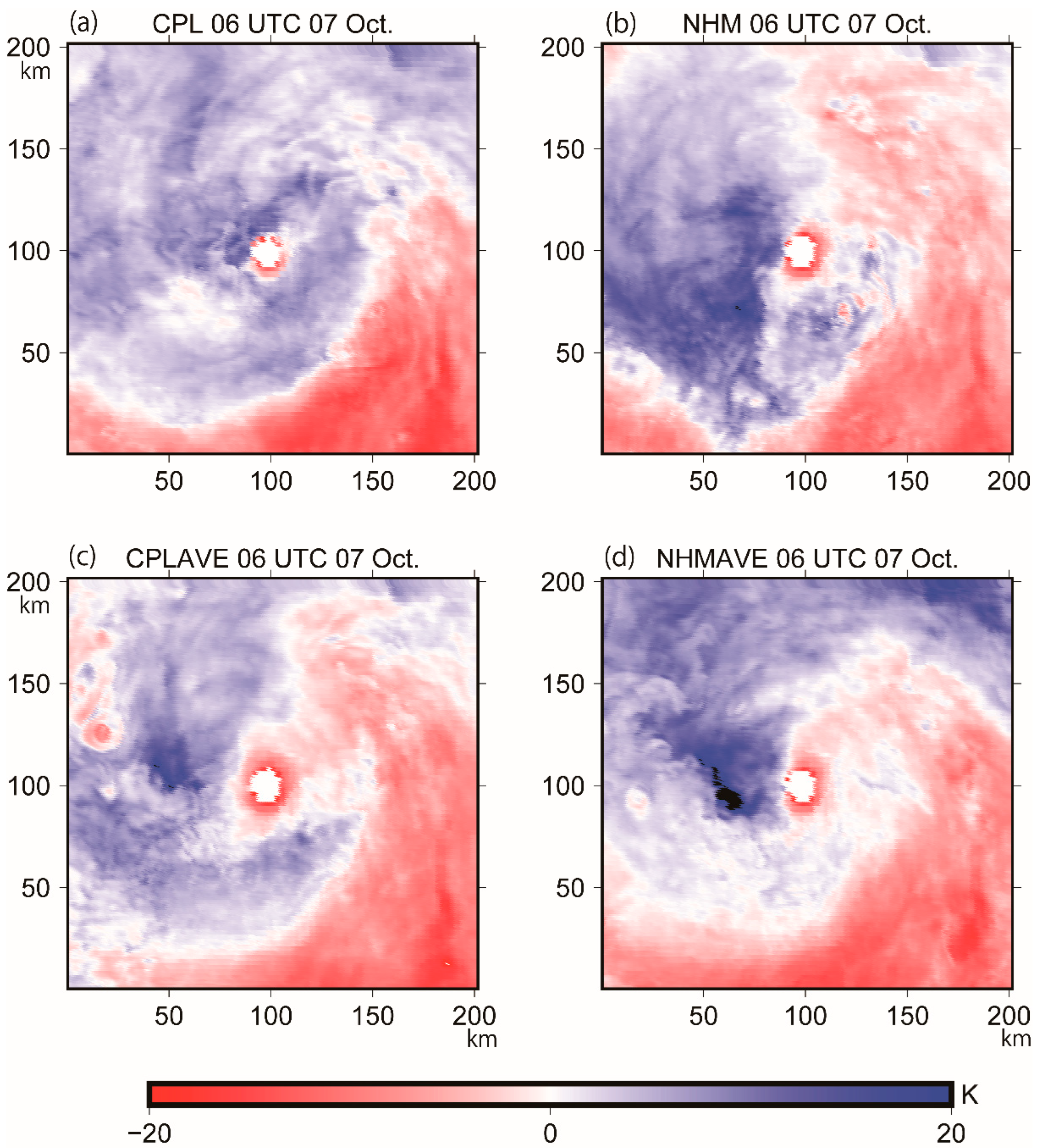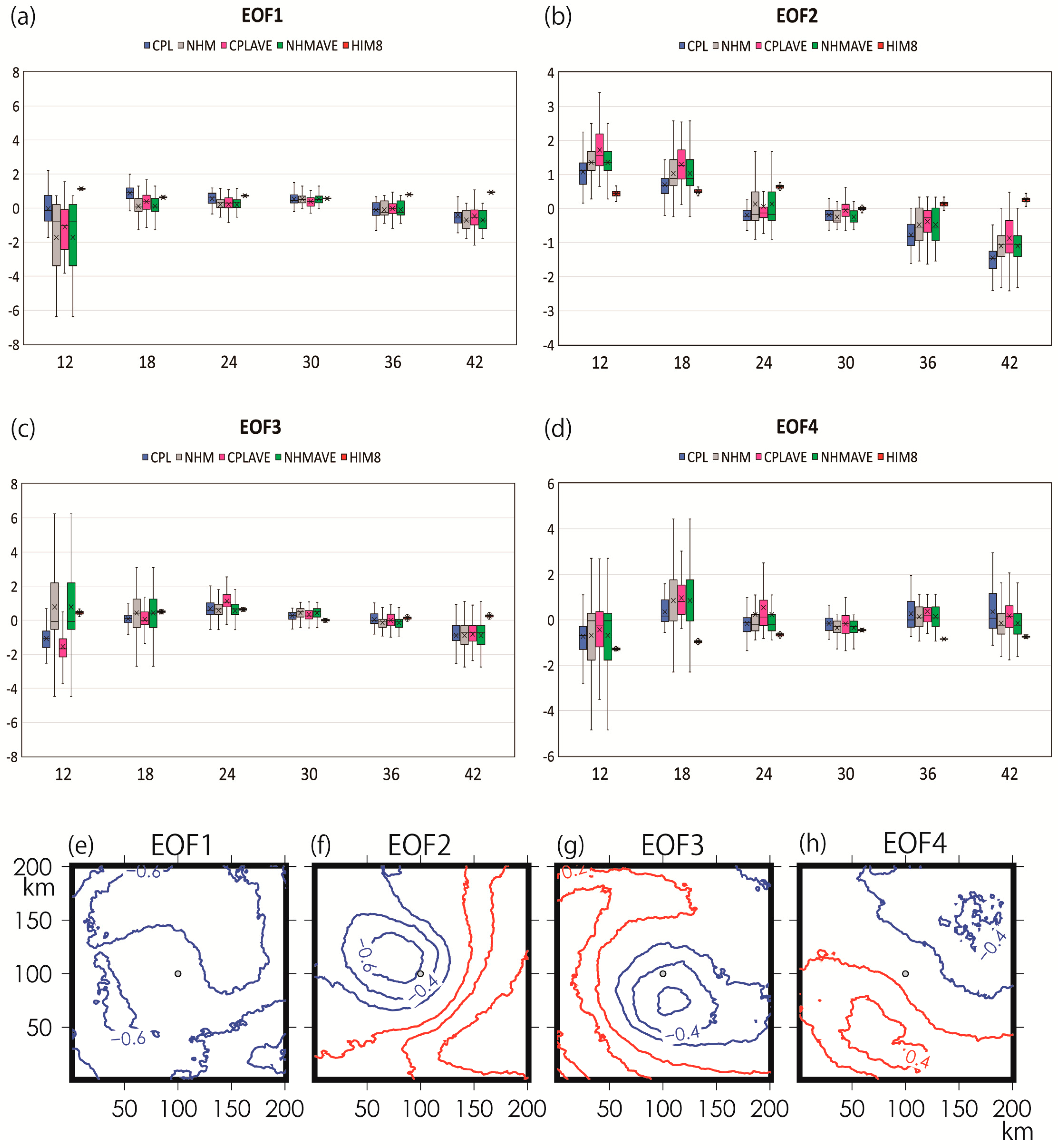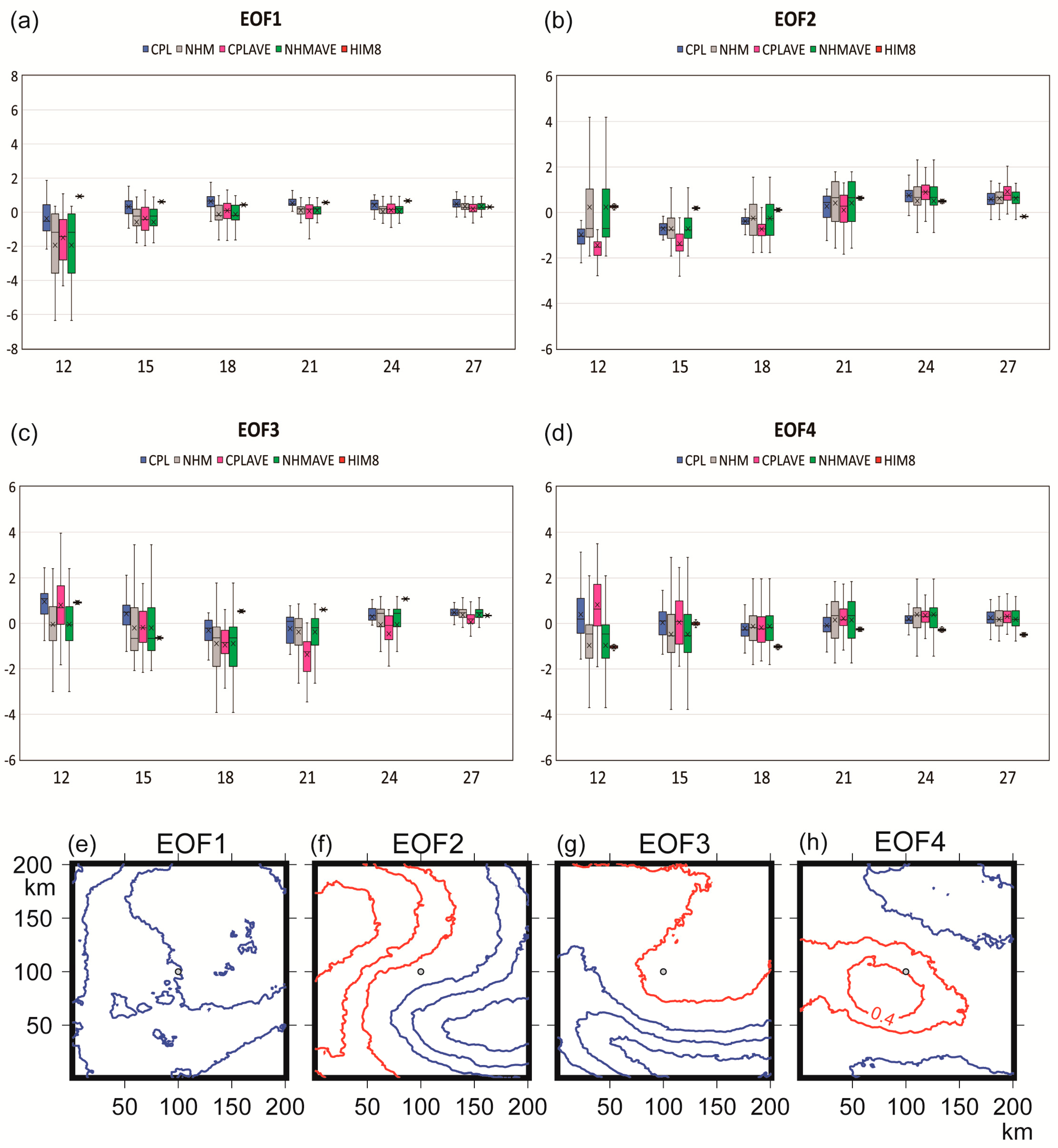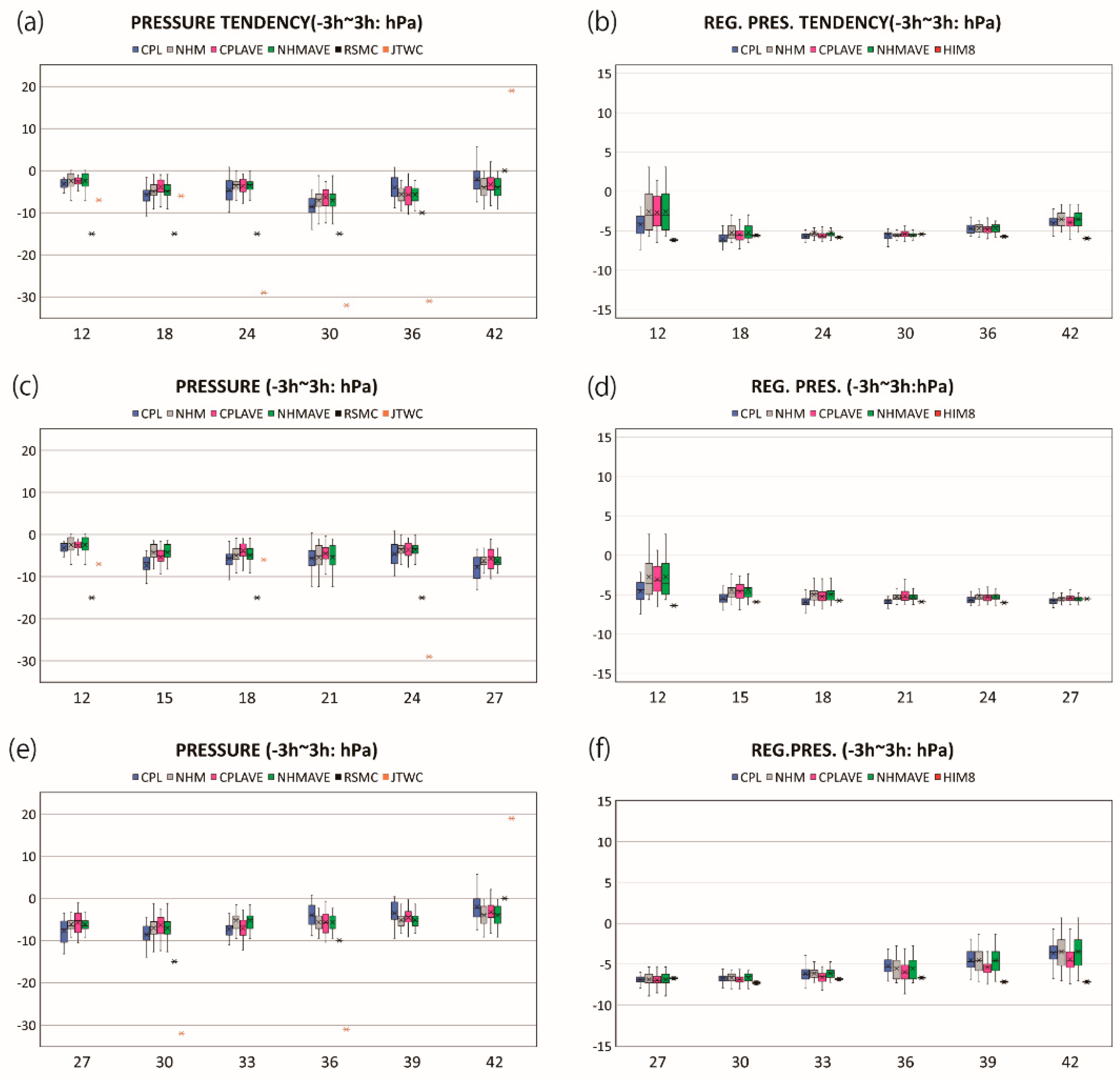Application of Empirical Orthogonal Function Analysis to 1 km Ensemble Simulations and Himawari–8 Observation in the Intensification Phase of Typhoon Hagibis (2019)
Abstract
:1. Introduction
2. Data and Methods
3. Results
3.1. Results of Ensemble Simulations
- 12−42 h every 6 h: the entire intensification phase.
- 12−27 h every 3 h: the early intensification phase from poorly defined circulation to well defined circulation.
- 27−42 h every 3 h: the late intensification phase from well–defined circulation to EYE.
3.2. Entire Intensification Phase
3.3. Early Intensification Phase
3.4. Late Intensification Phase
3.5. Prediction by Multiple Linear Regression Analysis
4. Discussion
5. Conclusions
Author Contributions
Funding
Informed Consent Statement
Data Availability Statement
Acknowledgments
Conflicts of Interest
References
- Thompson, D.W.J.; Wallace, J.M. The Arctic oscillation signature in the wintertime geopotential height and temperature fields. Geophys. Res. Lett. 1998, 25, 1297–1300. [Google Scholar] [CrossRef]
- Kikuchi, K. Extension of the bimodal intraseasonal oscillation index using JRA–55. Clim. Dyn. 2020, 54, 919–933. [Google Scholar] [CrossRef]
- Wheeler, M.C.; Hendon, H.H. An all–season real–time multivariate MJO index: Development of an index for monitoring and prediction. Mon. Wea. Rev. 2004, 132, 1917–1932. [Google Scholar] [CrossRef]
- Zheng, M.; Chang, E.K.M.; Colle, B.A.; Luo, Y.; Zhu, Y. Applying fuzzy clustering to a multimodel ensemble for U.S. East Coast winter storms: Scenario identification and forecast verification. Wea. Forecast. 2017, 32, 881–903. [Google Scholar] [CrossRef]
- Zheng, M.; Chang, E.K.M.; Colle, B.A. Evaluating U.S. East Coast winter storms in a multimodel ensemble using EOF and clustering approaches. Mon. Wea. Rev. 2019, 147, 1967–1987. [Google Scholar] [CrossRef]
- Wada, A.; Chan, J.C.L. Increasing TCHP in the western North Pacific and its influence on the intensity of FAXAI and HAGIBIS in 2019. SOLA 2021, 17A, 29–32. [Google Scholar] [CrossRef]
- Wada, A. Atmosphere–Wave–Ocean Coupled–Model Ensemble Simulation on Rapid Intensification of Typhoon Hagibis (2019). WGNE Res. Activ. Earth Sys. Modell. 2021, 51, 9–07–9–08. [Google Scholar]
- Heming, J.; Prates, F.; Bender, M.A.; Bowyer, R.; Cangialosi, J.; Caroff, P.; Coleman, T.; Doyle, J.D.; Dube, A.; Faure, G.; et al. Review of recent progress in tropical cyclone track forecasting and expression of uncertainties. Trop. Cyclone Res. Rev. 2019, 8, 181–218. [Google Scholar] [CrossRef]
- Yamaguchi, M.; Ishida, J.; Sato, H.; Nakagawa, M. WGNE Intercomparison of tropical cyclone forecasts by operational NWP Models: A quarter century and beyond. Bull. Amer. Meteor. Soc. 2017, 98, 2337–2349. [Google Scholar] [CrossRef]
- Emanuel, K.; Zhang, F. The role of inner–core moisture in tropical cyclone predictability and practical forecast skill. J. Atmos. Sci. 2017, 74, 2315–2324. [Google Scholar] [CrossRef]
- Wang, Y.; Wu, C.C. Current understanding of tropical cyclone structure and intensity changes—A review. Meteorol. Atmos. Phys. 2004, 87, 257–278. [Google Scholar] [CrossRef]
- Dvorak, V.F. Tropical cyclone intensity analysis using satellite data. NOAA Tech. Rep. 1984, 11, 45. [Google Scholar]
- Olander, T.L.; Velden, C.S. The advanced Dvorak technique (ADT) for estimating tropical cyclone intensity: Update and new capabilities. Wea. Forecast. 2019, 34, 905–922. [Google Scholar] [CrossRef]
- Velden, C.; Harper, B.; Wells, F.; Beven, J.L.; Zehr, R.; Olander, T.; Mayfield, M.; Guard, C.; Lander, M.; Edson, R.; et al. The Dvorak tropical cyclone intensity estimation technique: A satellite–based method that has endured for over 30 years. Bull. Amer. Meteor. Soc. 2006, 87, 1195–1210. [Google Scholar] [CrossRef]
- Oyama, R.; Nagata, K.; Kawada, H.; Koide, N. Development of a product based on consensus between Dvorak and AMSU tropical cyclone central pressure estimates at JMA. RSMC Tokyo–Typhoon Cent. Tech. Rev. 2016, 18, 1–8. [Google Scholar]
- Sasaki, H.; Motoi, T. Accelerated Increase in Tropical Cyclone Heat Potential in the Typhoon Rapidly Intensifying Zone during 1955–2020. SOLA 2022, 18, 65–70. [Google Scholar] [CrossRef]
- Bessho, K.; Date, K.; Hayashi, M.; Ikeda, A.; Imai, T.; Inoue, H.; Kumagai, Y.; Miyakawa, T.; Murata, H.; Ohno, T.; et al. An introduction to Himawari–8/9—Japan’s new–generation geostationary meteorological satellites. J. Meteor. Soc. Jpn. 2016, 94, 151–183. [Google Scholar] [CrossRef]
- Merrill, R.T. Environmental influences on hurricane intensification. J. Atmos. Sci. 1988, 45, 1678–1687. [Google Scholar] [CrossRef]
- Kaplan, J.; DeMaria, M. Large–scale characteristics of rapidly intensifying tropical cyclones in the North Atlantic basin. Wea. Forecast. 2003, 18, 1093–1108. [Google Scholar] [CrossRef]
- Hendricks, E.A.; Peng, M.S.; Fu, B.; Li, T. Quantifying environmental control on tropical cyclone intensity change. Mon. Wea. Rev. 2010, 138, 3243–3271. [Google Scholar] [CrossRef]
- Rios–Berrios, R.; Torn, R.D. Climatological analysis of tropical cyclone intensity changes under moderate vertical wind shear. Mon. Wea. Rev. 2017, 145, 1717–1738. [Google Scholar] [CrossRef]
- Harnos, D.S.; Nesbitt, S.W. Convective structure in rapidly intensifying tropical cyclones as depicted by passive microwave measurements. Geophys. Res. Lett. 2011, 38, L07805. [Google Scholar] [CrossRef]
- Shi, D.; Chen, G. The implication of outflow structure for the rapid intensification of tropical cyclones under vertical wind shear. Mon. Wea. Rev. 2021, 149, 4107–4127. [Google Scholar] [CrossRef]
- Fischer, M.S.; Tang, B.H.; Corbosiero, K.L.; Rozoff, C.M. Normalized convective characteristics of tropical cyclone rapid intensification events in the North Atlantic and Eastern North Pacific. Mon. Wea. Rev. 2018, 146, 1133–1155. [Google Scholar] [CrossRef]
- Rios–Berrios, R.; Davis, C.A.; Torn, R.D. A hypothesis for the intensification of tropical cyclones under moderate vertical wind shear. J. Atmos. Sci. 2018, 75, 4149–4173. [Google Scholar] [CrossRef]
- Tao, D.; Zhang, F. Evolution of dynamic and thermodynamic structures before and during rapid intensification of tropical cyclones: Sensitivity to vertical wind shear. Mon. Wea. Rev. 2019, 147, 1171–1191. [Google Scholar] [CrossRef]
- Dai, Y.; Majumdar, S.J.; Nolan, D.S. Tropical cyclone resistance to strong environmental shear. J. Atmos. Sci. 2021, 78, 1275–1293. [Google Scholar] [CrossRef]
- Hardy, S.; Schwendike, J.; Smith, R.K.; Short, C.J.; Reeder, M.J.; Birch, C.E. Fluctuations in inner–core structure during the rapid intensification of super typhoon Nepartak (2016). Mon. Wea. Rev. 2021, 149, 221–243. [Google Scholar] [CrossRef]
- RSMC Tokyo–Typhoon Center Best Track Data. Available online: https://www.jma.go.jp/jma/jma–eng/jma–center/rsmc–hp–pub–eg/trackarchives.html (accessed on 22 August 2022).
- Naval Oceanography Portal Tropical Cyclone Support Best Track Archive. Available online: https://www.metoc.navy.mil/jtwc/jtwc.html?best–tracks (accessed on 22 August 2022).
- Wada, A.; Kanada, S.; Yamada, H. Effect of air–sea environmental conditions and interfacial processes on extremely intense typhoon Haiyan (2013). J. Geophys. Res. Atmos. 2018, 123, 10379–10405. [Google Scholar] [CrossRef]
- Ikawa, M.; Saito, K. Description of a nonhydrostatic model developed at the forecast research department of the MRI. Tech. Rep. MRI 1991, 28, 238. [Google Scholar] [CrossRef]
- Lin, Y.L.; Farley, R.D.; Orville, H.D. Bulk parameterization of the snow field in a cloud model. J. Appl. Meteor. Climatol. 1983, 22, 1065–1092. [Google Scholar] [CrossRef]
- Kondo, J. Air–sea bulk transfer coefficients in diabatic conditions. Bound. Layer Meteor. 1975, 9, 91–112. [Google Scholar] [CrossRef]
- Taylor, P.K.; Yelland, M.J. The dependence of sea surface roughness on the height and steepness of the waves. J. Phys. Oceanogr. 2001, 31, 572–590. [Google Scholar] [CrossRef]
- Klemp, J.B.; Wilhelmson, R. The simulation of three–dimensional convective storm dynamics. J. Atmos. Sci. 1978, 35, 1070–1096. [Google Scholar] [CrossRef]
- Deardorff, J.W. Stratocumulus–capped mixed layers derived from a three–dimensional model. Bound. Layer Meteor. 1980, 18, 495–527. [Google Scholar] [CrossRef]
- Sugi, M.; Kuma, K.; Tada, K.; Tamiya, K.; Hasegawa, N.; Iwasaki, T.; Yamada, S.; Kitade, T. Description and performance of the JMA operational global spectral model (JMA–GSM88). Geophys. Mag. 1990, 43, 105–130. [Google Scholar]
- Remote Sensing Systems Measurement Sea Surface Temperature. Available online: https://www.remss.com/measurements/sea–surface–temperature (accessed on 22 August 2022).
- Usui, N.; Wakamatsu, T.; Tanaka, Y.; Hirose, N.; Toyoda, T.; Nishikawa, S.; Fujii, Y.; Takatsuki, Y.; Igarashi, H.; Nishikawa, H.; et al. Four–dimensional variational ocean reanalysis: A 30–year high–resolution dataset in the western North Pacific (FORA–WNP30). J. Oceanogr. 2017, 73, 205–233. [Google Scholar] [CrossRef]
- Eumetsat NWP SAF RTTOV v13. Available online: https://nwp–saf.eumetsat.int/site/software/rttov/rttov–v13/ (accessed on 22 August 2022).
- Nakazawa, T.; Hoshino, S. Intercomparison of Dvorak parameters in the tropical cyclone datasets over the western North Pacific. SOLA 2009, 5, 33–36. [Google Scholar] [CrossRef]
- Atcf Tropical Cyclone Database. Available online: https://www.nrlmry.navy.mil/atcf_web/docs/database/new/database.html (accessed on 22 August 2022).
- Kitabatake, N.; Hoshino, S.; Sakuragi, T. Estimation of tropical cyclone intensity using TRMM/TMI brightness temperature data with asymmetric components. Pap. Meteor. Geophys. 2014, 65, 57–74. [Google Scholar] [CrossRef]
- North, G.R.; Bell, T.L.; Cahalan, R.F.; Moeng, F.J. Sampling errors in the estimation of empirical orthogonal functions. Mon. Wea. Rev. 1982, 110, 699–706. [Google Scholar] [CrossRef]
- Wada, A. Idealized numerical experiments associated with the intensity and rapid intensification of stationary tropical–cyclone–like vortex and its relation to initial sea–surface temperature and vortex–induced sea–surface cooling. J. Geophys. Res. Atmos. 2009, 114, D18111. [Google Scholar] [CrossRef]
- Horinouchi, T.; Shimada, U.; Wada, A. Convective bursts with gravity waves in tropical cyclones: Case study with the Himawari–8 satellite and idealized numerical study. Geophys. Res. Lett. 2020, 47, e2019GL086295. [Google Scholar] [CrossRef]
- Chen, B.; Chen, B.; Lin, H.; Elsberry, R.L. Estimating tropical cyclone intensity by satellite imagery utilizing convolutional neural networks. Wea. Forecast. 2019, 34, 447–465. [Google Scholar] [CrossRef]








| NHM | CPL | NHMAVE | CPLAVE | |
|---|---|---|---|---|
| model | A nonhydrostatic atmosphere model | Coupled atmosphere–wave–ocean model | A nonhydrostatic atmosphere model | Coupled atmosphere–wave–ocean model |
| Microphysics | Ikawa and Saito (1991) [32], Lin et al. (1983) [33] | |||
| Surface flux | Kondo (1975) [34] | Taylor and Yelland (2001) [35], Wada et al. (2018) [31] | Kondo (1975) [34] | Taylor and Yelland (2001) [35], Wada et al. (2018) [31] |
| Turbulence | Klemp and Wilhelmson (1978) [36], Deardorff (1980) [37] | |||
| Radiation | Sugi et al. (1990) [38] | |||
| NHM | CPL | NHMAVE | CPLAVE | |
|---|---|---|---|---|
| Simulation period | From 00 UTC on 6 October (initial time) to 18 UTC on 7 October in 2019 | |||
| Time step | 3 s | 3 s (Atmosphere), 18 s (Ocean), 6 min (Ocean wave) | 3 s | 3 s (Atmosphere), 18 s (Ocean), 6 min (Ocean wave) |
| Computational domain and map system | 1620 km x 990 km centered at 15° N, 150° E, Lambert Conformal Conic projection | |||
| Horizontal resolution and vertical layer | 1 km and 55 levels in vertical coordinates with intervals ranging from 40 m for the near–surface layer to 1180 m for the uppermost layer (top height is 27,440 m) | |||
| SST | Microwave SST on 5 October | Microwave SST on 5 October | Climatological mean microwave SST on 5 October during 1999–2018 | Climatological mean microwave SST on 5 October during 1999–2018 |
| Ocean data (temperature, salinity, and current velocities) | – | JMA mean North Pacific oceanic daily analysis on 5 October | – | Climatological mean North Pacific Ocean daily reanalysis [36] on 5 October during 1993–2018 (including JMA analysis during 2016–2018) |
| Atmospheric data | JMA 6 hourly global atmospheric analysis data with a horizontal grid spacing of approximately 20 km | |||
| Perturbation | JMA global atmospheric ensemble prediction data with a horizontal grid spacing of 1.25° at 00 UTC on 6 October | |||
| The number of ensemble simulation | 1 control experiment and 26 experiments with perturbation | |||
Publisher’s Note: MDPI stays neutral with regard to jurisdictional claims in published maps and institutional affiliations. |
© 2022 by the authors. Licensee MDPI, Basel, Switzerland. This article is an open access article distributed under the terms and conditions of the Creative Commons Attribution (CC BY) license (https://creativecommons.org/licenses/by/4.0/).
Share and Cite
Wada, A.; Hayashi, M.; Yanase, W. Application of Empirical Orthogonal Function Analysis to 1 km Ensemble Simulations and Himawari–8 Observation in the Intensification Phase of Typhoon Hagibis (2019). Atmosphere 2022, 13, 1559. https://doi.org/10.3390/atmos13101559
Wada A, Hayashi M, Yanase W. Application of Empirical Orthogonal Function Analysis to 1 km Ensemble Simulations and Himawari–8 Observation in the Intensification Phase of Typhoon Hagibis (2019). Atmosphere. 2022; 13(10):1559. https://doi.org/10.3390/atmos13101559
Chicago/Turabian StyleWada, Akiyoshi, Masahiro Hayashi, and Wataru Yanase. 2022. "Application of Empirical Orthogonal Function Analysis to 1 km Ensemble Simulations and Himawari–8 Observation in the Intensification Phase of Typhoon Hagibis (2019)" Atmosphere 13, no. 10: 1559. https://doi.org/10.3390/atmos13101559
APA StyleWada, A., Hayashi, M., & Yanase, W. (2022). Application of Empirical Orthogonal Function Analysis to 1 km Ensemble Simulations and Himawari–8 Observation in the Intensification Phase of Typhoon Hagibis (2019). Atmosphere, 13(10), 1559. https://doi.org/10.3390/atmos13101559






